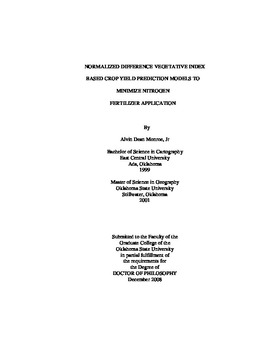| dc.contributor.advisor | Solie, John | |
| dc.contributor.author | Monroe, Alvin Dean, Jr. | |
| dc.date.accessioned | 2018-05-30T16:47:41Z | |
| dc.date.available | 2018-05-30T16:47:41Z | |
| dc.date.issued | 2008-12 | |
| dc.identifier.uri | https://hdl.handle.net/11244/299965 | |
| dc.description.abstract | Scope and Method of Study: The purpose of this study was to develop a theoretical basis and numerical strategy to optimize nitrogen (N) fertilizer application and thereby improve crop yield potential models, increase economic efficiency, and reduce excess N entering the environment. This study focused on formulating systematic continuous functions to describe the relationship between plant response to supplemental N fertilizer and spectral measures of plant stand quality (normalized difference vegetative index or NDVI). A derived continuous definition of plant response to N was combined with current agronomic theory to extend current yield potential modeling equations. Secondary research in this study evaluated the estimation and use of fractional vegetative cover as an ancillary description of yield. | |
| dc.description.abstract | Findings and Conclusions: This study found that plant response to supplemental nitrogen (N) is functionally related to plant stand quality and residual N sufficiency measured by NDVI. Specifically plant response to supplemental N decreases as plant stand quality increases as a function of residual N from the plant-soil matrix. A sigmoidal yield equation was proposed to replace existing yield potential models, which incorporated agronomic boundary conditions and continuous plant response to supplemental N. This study demonstrated that the sigmoidal yield curve integrated continuous plant response to N supplementation and biological constraints more effectively than current empirically derived models. Additionally, the sigmoidal model demonstrated a method of predicting the maximum biophysical limit of yield and provided a quantifiable estimate of yield gain. Furthermore, yield gain was found to be subject to N application rate and further research could be developed to derive the economic net benefit of application rate for specific plant stands. Secondary research in this study also found that fractional vegetative cover could be estimated by a systematic relationship between the mean and variance of NDVI measured by sub-sampling sensors. This finding did not directly contribute to yield prediction, but provides an applicable method for estimating fractional vegetative cover in the field with the use of sub-sampling optical sensors. | |
| dc.format | application/pdf | |
| dc.language | en_US | |
| dc.rights | Copyright is held by the author who has granted the Oklahoma State University Library the non-exclusive right to share this material in its institutional repository. Contact Digital Library Services at lib-dls@okstate.edu or 405-744-9161 for the permission policy on the use, reproduction or distribution of this material. | |
| dc.title | Normalized difference vegetative index based crop yield prediction models to minimize nitrogen fertilizer application | |
| dc.contributor.committeeMember | Raun, William | |
| dc.contributor.committeeMember | Weckler, Paul | |
| dc.contributor.committeeMember | Storm, Daniel | |
| dc.contributor.committeeMember | Comer, Jonathan | |
| osu.filename | Monroe_okstate_0664D_10047.pdf | |
| osu.accesstype | Open Access | |
| dc.type.genre | Dissertation | |
| dc.type.material | Text | |
| thesis.degree.discipline | Environmental Science | |
| thesis.degree.grantor | Oklahoma State University | |
